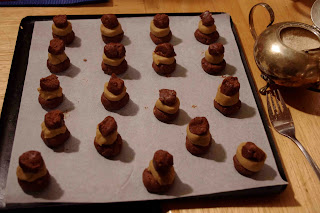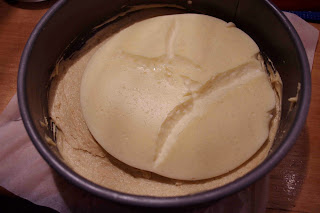I’ve made this cake several times since it was invented some winters ago by one who is known on
blogs far and wide as the Cake-maker Extraordinaire. The CME put quince on the map as far as I was concerned, and her pairing it with cardamom was truly inspired. I am honoured to follow in her Camper footsteps in transforming these ungainly furry yellow fruit to an aromatic ruby-red delight, with a slab of vanilla custard sandwiched by cake to go underneath.
Quinces can be pot-roasted in a leisurely and civilised fashion for many hours in the oven with excellent results and a most fragrant kitchen
as CME does, or pressure-cooked in under an hour as I did this time (adapted from Suzanne Gibb’s
Pressure Cooker Recipe Book, p159).
I cup white wine or verjuice plus one cup water
2 cups sugar – I used raw this time for more flavour
stick cinnamon, a vanilla bean, a clove or two, perhaps a few cardamom pods or some lemon peel
4–6 quinces, depending on size, quartered and peeled (if you like, as I do – or just scrub the fuzz off), but not cored – that’s more easily done afterwards, and the pectin in the cores possibly helps the syrup to thicken.
Put liquids and sugar into pressure cooker and bring to the boil, stirring to dissolve sugar. Add quince quarters and lock the lid. Bring the pressure cooker to low pressure over medium–high heat and cook for 40–50 minutes. After the lid is unlocked, you’ll probably see that the quinces are pinker than they were, but they’ll continue to redden as they cool in the syrup.
If the syrup isn’t thick enough, keep cooking with the lid off to reduce. Once the quinces are cool enough to handle, carefully cut the cores away before returning them to the syrup. They can be refrigerated for a few weeks or frozen for future reference, and used in the next quince-and-cardamon-custard cake that is called for.
Custard
2 eggs
2 tablespoons cornflour
500mL milk
2 tablespoons sugar
1 teaspoon vanilla extract or a vanilla bean
Whisk together the eggs, cornflour and milk in a saucepan, and then place over low–medium heat, continuing to whisk until thickened, 10–15 minutes. Take off the heat and whisk in the sugar and vanilla extract, or scrape in the bean. Pour into a soup bowl or suchlike so that the custard settles in a shallow pool of a smaller diameter than the cake tin you plan to use. Leave to cool, and ideally refrigerate overnight* – the custard will be more solid and easier to work with.
Cake
200g room-temperature unsalted butter
50g raw sugar
100g light muscovado or brown sugar
½ teaspoon salt
2 eggs
300g plain flour
2 teaspoons baking powder
½ teaspoon ground cardamom
½ cup buttermilk (or normal milk with ¼ teaspoon vinegar left to stand 15 minutes)
20g butter
2 teaspoons caster sugar
½ teaspoon ground cardamom
a couple of handfuls slivered almonds or pistachios
pot-roasted or pressure-cooked quinces – 2 or 3 depending on size
Preheat oven to 180C.
Sift the flour, baking powder and first ½ teaspoon cardamom; set aside.
Beat the butter until creamy and add both sugars and salt. Beat until pale, then add the eggs one at a time. Add the flour in two goes, with the buttermilk in between, and mix in just until incorporated.
Spread half the resulting thick batter over the base of a lined 20–22cm springform tin, and carefully slide the cold custard on top. Then cover with the rest of the batter as best you can, working from the outside in and trying not to break up the custard too much.
Arrange generous slices of quince over the top, neatly or messily as they come. Drizzle with some syrup for good measure. Brush with the extra melted butter and sprinkle with caster sugar, more cardamom and chopped nuts.
Bake for 1 hour and 15 minutes, or more like 2 in my oven. Let it cool completely before cutting, and be rewarded with a neat horizontal seam of custard winding through the slice.
*Rather than refrigerated overnight as I have done in the past, this time the custard was just cooled; it split a bit and would have melded with the top layer of batter if I’d let it. Don’t do what I did another time, and pour in the custard still warm due to needing to get to my uncle’s house in the country for lunch – it just blends itself in with the cake batter and when the first slice is cut it appears completely uncooked.































